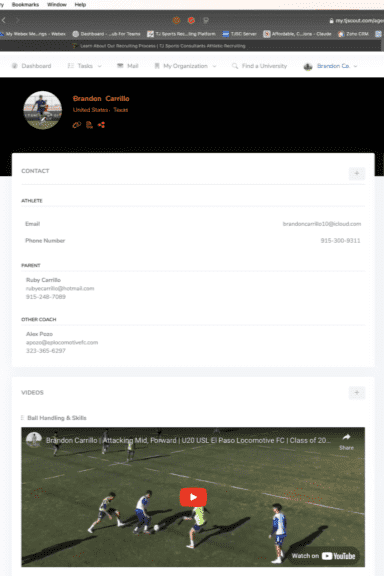NCAA
Here’s everything you need to know about NCAA eligibility and academic requirements. If you need further information
NCAA Division Levels

NCAA DI
DIVISION I Division I schools, on average, enroll the most students, manage the largest athletics budgets, offer a wide array of academic programs and provide the most athletics scholarships.
Participation
- 179,200 Student-Athletes
- 351 Colleges and Universities
ATHLETICS SCHOLARSHIPS
- 59 percent of all student-athletes receive some level of athletics aid
ACADEMICS
- 2017 Graduation Success
- Rate 87 percent*Â
OTHER STATS
- Median Undergraduate Enrollment: 9,629
- Average Number of Teams per School: 19
- Average Percentage of Student Body Participating in Sports: 4 percent Division I National Championships: 26
NCAA DII
Division II provides growth opportunities through academic achievement, high-level athletics competition and community engagement. Many participants are first-generation college students.
Participation
- 121,900 Student-Athletes
- 308 Colleges and Universities
ATHLETICS SCHOLARSHIPS
- 62 percent of all student-athletes receive some level of athletics aid
ACADEMICS
- 2017 Graduation Success
- Rate 72 percent*Â
OTHER STATS
- Median Undergraduate Enrollment: 2,485
- Average Number of Teams per School: 16
- Average Percentage of Student Body Participating in Sports: 9 percent Division I National Championships: 25


Division III
The Division III experience provides an integrated environment that focuses on academic success while offering competitive athletics and meaningful non athletic opportunities.
Participation
- 190,900 Student-Athletes
- 443 Colleges and Universities
ATHLETICS SCHOLARSHIPS
- 80 percent of all student-athletes receive some form of academic grant or need-based scholarship; institutional gift aid totals $ 17,000 on average
ACADEMICS
- 2017 Graduation Success
- Rate 87 percent*Â
OTHER STATS
- Median Undergraduate Enrollment: 1,748
- Average Number of Teams per School: 18
- Average Percentage of Student Body Participating in Sports: 26 percent Division I National Championships: 28
Eligibility Requirements
If your goal is to be recruited by NCAA DI or DII schools, you will need to register with the NCAA Eligibility Center. The registration fee is $100 for athletes in the U.S., U.S. territories and Canada. For international athletes, the cost is $180. If you are unable to pay this fee, the NCAA does have fee waiver options available.

Division I or II
You need to be certified by the NCAA Eligibility Center to compete at an NCAA Division I or II school. You also need to be registered with a Certification Account before you can make official visits or sign a National Letter of Intent in Division I or II.
Division III or Undecided
If you plan to compete at a Division III school or are currently unsure in which division you want to compete, create a Profile Page. If at any time you wish to pursue a Division I or II path, you will be able to transition to a Certification Account.
NCAA D1
To be classified as a Division I member institutions with the NCAA, the university must sponsor at least seven sports for men and seven for women (or six for men and eight for women) with two team sports for each gender. Each sport is also regulated with the number of contests and participants they must have in addition to scheduling criteria. One hundred percent of all contests must be between other Division I level programs with the exception of football and basketball. Football Bowl Subdivision teams have to meet minimum attendance requirements (average 15,000 people in actual or paid attendance per home game), which must be met once in a rolling two-year period. NCAA Football Championship Subdivision teams do not need to meet minimum attendance requirements. Division I schools must meet minimum financial aid awards for their athletics program.
NCAA D2
To be classified as a Division II member institutions with the NCAA, the university must sponsor at least five sports for men and five for women (or six for men and eight for women) with two team sports for each gender. Each sport is also regulated with the number of contests and participants they must have in addition to scheduling criteria. Football and men’s and women’s basketball teams must play at least 50 percent of their games against Division II or Football Bowl Subdivision (formerly Division I-A) or Football Championship Subdivision (formerly Division I-AA) opponents. For sports other than football and basketball there are no scheduling requirements. Division II programs do not have any attendance requirements but they do have maximum financial aid awards that they must not exceed. Many athletes that compete on the Division II level receive financial aid in the form of athletic and academic grants, loans and work study programs.
NCAA D3
To be classified as a Division III member institutions with the NCAA, the university must sponsor at least five sports for men and five for women (or six for men and eight for women) with two team sports for each gender. Division III athletes may not receive financial aid in the form of athletic scholarships or grants but they may receive academic grants and need based financial aid for college.
Frequently Asked Questions
A descriptive paragraph that tells clients how good you are and proves that you are the best choice that they’ve made.
How is TJ Sports different from other recruiting platforms?
Unlike automated databases, we offer a hands-on, personalized approach. Our team actively engages with college coaches on your behalf, combining real-world relationships with technology to find your best fit.
What does the recruiting process look like from start to finish?
After an academic and athletic review, we build your athlete profile, develop your university list, and begin targeted outreach to programs that align with your goals. We guide you through each step, including communication strategies, visits, and decision-making.
What level of schools do you work with (D1, D2, D3, NAIA, etc.)?
We work across all college divisions—NCAA (D1, D2, D3), NAIA, and JUCO—based on your academic profile, athletic ability, and personal goals. The focus is on finding the right fit, not just the biggest name.
Do you guarantee a scholarship or placement?
While we can’t guarantee offers, our proven methods significantly improve your chances. Our athletes benefit from consistent exposure, strategic outreach, and guidance that often leads to scholarship opportunities and successful placements.
------
NCAA Recruiting Calendars
------
NCAA member schools have adopted rules to create an equitable recruiting environment that promotes student-athlete well-being. The rules define who may be involved in the recruiting process, when recruiting may occur and the conditions under which recruiting may be conducted. Recruiting rules seek, as much as possible, to control intrusions into the lives of student-athletes. The NCAA defines recruiting as any solicitation of prospective student-athletes or their parents by an institutional staff member or by a representative of the institution athletics interests for the purpose of securing a prospective student-athletes enrollment and ultimate participation in the institution intercollegiate athletics program.
------
Division I & II Recruiting Calendars
------

Join TJ Sports Consultants
Access the tools you need to get recruited.
Create an account with us today and get noticed by talent scouts and coaches across the United States.



